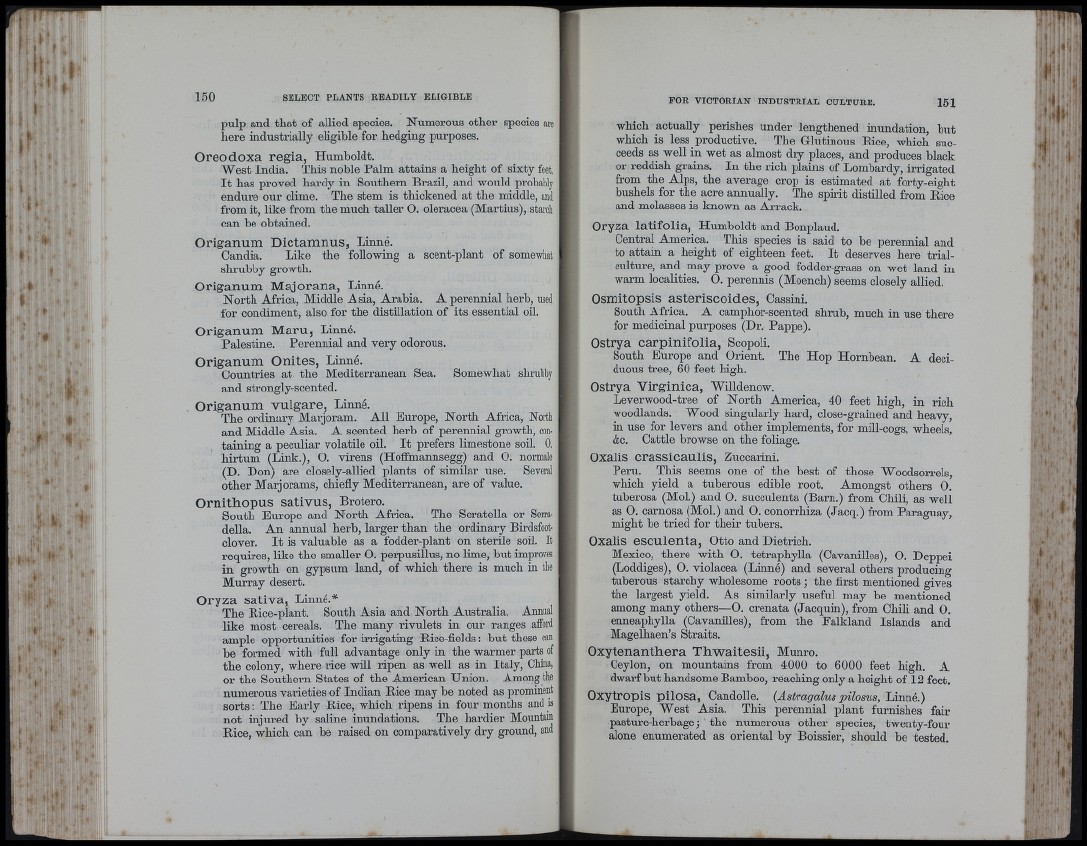
. I '! \ l '
• I . ■ i l f l •
! , t l ' '
,r ib 4
i . ^ i
* 1 ‘
j '
ii 3
h
'A
I
150 SELECT PLANTS READILY ELIGIBLE
pulp and that of allied species. Numerous other species are
liere industrially eligible for hedging purposes.
Oreodoxa regia, Humboldt.
West India. This noble Palm attains a height of sixty feet,
I t has proved hardy in Southern Brazil, and would probably
endure our clime. The stem is thickened at the middle, and
from it, like from the much taller 0. olerácea (Martins), starcli
can be obtained.
Origanum Dictamnus, Linné.
Candia. Like the following a scent-plant of somewhat
shrubby growth.
Origanum Majorana, Linné.
North Africa, Middle Asia, Arabia. A perennial herb, nsei
for condiment, also for tbe distillation of its essential oil.
Origanum Maru, Linné.
Palestine. Perennial and very odorous.
Origanum Onites, Linné.
Countries at the Mediterranean Sea. Somewhat shrubby
and strongly-scented.
Origanum vulgare, Linné.
The ordinary Marjoram. All Europe, North Africa, North
and Middle Asia. A scented herb of perennial growth, containing
a peculiar volatile oil. I t prefers limestone soil. 0,
hirtum (Link.), 0 . virens (Hoffmannsegg) and 0. normale
(D. Don) are closely-allied plants of similar use. Several
other Marjorams, chiefly Mediterranean, are of value.
Ornithopus sativus, Brotero.
South Europe and North Africa. The Seratella or Serradella.
An annual herb, larger than the ordinary Birdsfoot-
clover. I t is valuable as a fodder-plant on sterile soil. It
requires, like the smaller 0 . perpusillus, no lime, but improves
in growth on gypsum land, of which there is much in the
Murray desert.
Oryza sativa, Linné.*
The Bice-plant. South Asia and North Australia. Annual
like most cereals. The many rivulets in our ranges afford
ample opportunities for irrigating Bice-fields : but these can
be formed with full advantage only in the warmer parts of
tbe colony, where rice will ripen as well as in Italy, China,
or the Southern States of the American Union. Among the
numerous varieties of Indian Bice may be noted as prominent
sorts; Tbe Early Bice, which ripens in four months and is
not injured by saline inundations. The hardier Mountain
Rice, which can be raised on comparatively dry ground, and
FOR VICTORIAN INDUSTRIAL CULTURE. 151
which actually perishes under lengthened inundation, bnt
which is less productive. The Glutinous Rice, which succeeds
as well in wet as almost dry places, and produces black
or reddish grains. In the rich plains of Lombardy, irrigated
from tbe Alps, the average crop is estimated at forty-eight
bushels for the acre annually. The spirit distilled from Rice
and molasses is known as Arrack.
Oryza latifolia, Humboldt and Bonplaud.
Central America. This species is said to be perennial and
to attain a height of eighteen feet. I t deserves here trial-
culture, and may prove a good fodder-grass on wet land in
warm localities. O. perennis (Moench) seems closely allied.
Osmitopsis asteriscoid.es, Cassini.
South Africa. A camphor-scented shrub, much in use there
for medicinal purposes (Dr. Pappe).
Ostrya carpinifolia, Scopoli.
South Europe and Orient. The Hop Hornbean. A deciduous
tree, 60 feet high.
Ostrya Virginica, Willdenow.
Leverwood-tree of North America, 40 feet high, in rich
woodlands. Wood singularly hard, close-grained and heavy,
in use for levers and other implements, for mill-cogs, wheels,
(fee. Cattle browse on the foliage.
Oxalis crassicaulis, Zuccarini.
Peru. This seems one of the best of those Woodsorrels,
which yield a tuberous edible root. Amongst others O.
tuberosa (Mol.) and 0. succulenta (Barn.) from Cbili, as well
as 0. carnosa (Mol.) and O. conorrbiza (Jacq.) from Paraguay,
might be tried for their tubers.
Oxalis esculenta, Otto and Dietrich.
Mexico, there with 0 . tetraphylla (Cavanilles), O. Deppei
(Loddiges), O. violacea (Linné) and several others producing
tuberous starchy wholesome roots ; the first mentioned gives
the largest yield. As similarly useful may be mentioned
among many others—0. crenata (Jacquin), from Chili and O.
enneaphylla (Cavanilles), from the Falkland Islands and
Magelhaen’s Straits.
Oxytenanthera Thwaitesii, Munro.
Ceylon, on mountains from 4000 to 6000 feet high. A
dwarf bnt handsome Bamboo, reaching only a height of 12 feet.
Oxytropis pilosa, Candolle. (Astragalus pilosus, Linné.)
Europe, West Asia. This perennial plant furnishes fair
pasture-herbage; the numerous other species, twenty-four
alone enumerated as oriental by Boissier, should be tested.
i f
' J